|
|
|
Sort Order |
|
|
|
Items / Page
|
|
|
|
|
|
|
| Srl | Item |
| 1 |
ID:
110696


|
|
|
|
|
| Publication |
2011.
|
| Summary/Abstract |
The adoption and sustained use of improved cookstoves are critical performance parameters of the cooking system that must be monitored just like the rest of the stove technical requirements to ensure the sustainability of their benefits. No stove program can achieve its goals unless people initially accept the stoves and continue using them on a long-term basis. When a new stove is brought into a household, commonly a stacking of stoves and fuels takes place with each device being used for the cooking practices where it fits best. Therefore, to better understand the adoption process and assess the impacts of introducing a new stove it is necessary to examine the relative advantages of each device in terms of each of the main cooking practices and available fuels. An emerging generation of sensor-based tools is making possible continuous and objective monitoring of the stove adoption process (from acceptance to sustained use or disadoption), and has enabled its scalability. Such monitoring is also needed for transparent verification in carbon projects and for improved dissemination by strategically targeting the users with the highest adoption potential and the substitution of cooking practices with the highest indoor air pollution or greenhouse gas contributions.
|
|
|
|
|
|
|
|
|
|
|
|
|
|
|
|
| 2 |
ID:
168324
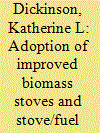

|
|
|
|
|
| Summary/Abstract |
In order to support transitions away from open-fire cooking and toward cleaner household energy systems, a better understanding of users’ technology adoption patterns and preferences is needed. This paper highlights key factors influencing use of two types of biomass-burning stoves provided through the REACCTING (Research on Emissions, Air quality, Climate, and Cooking Technology in Northern Ghana) randomized intervention study. We examine traditional and improved stove use over a two year follow up period, finding that the more basic rocket stove was used at a higher rate than the higher-tech gasifier stove. While stove use patterns varied by stove group, region, primary cook occupation, and socioeconomic status, use of traditional stoves remained high across most groups. Users perceived that improved stoves were less suitable for cooking a staple dish, Tuo Zaafi (TZ), and technical problems (e.g., battery failures with the gasifier stove) also limited the effectiveness of the intervention. Moving forward, household energy policies should prioritize a range of technologies that have potential to meet local needs while delivering meaningful health and/or environmental benefits, recognizing that stove and fuel “stacking” is likely to persist. A greater focus on markets and enabling environments is needed to support sustainable and scalable energy transitions.
|
|
|
|
|
|
|
|
|
|
|
|
|
|
|
|
| 3 |
ID:
149986
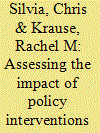

|
|
|
|
|
| Summary/Abstract |
Heightened concern regarding climate change and energy independence has increased interest in plug-in electric vehicles as one means to address these challenges and governments at all levels have considered policy interventions to encourage their adoption. This paper develops an agent-based model that simulates the introduction of four policy scenarios aimed at promoting electric vehicle adoption in an urban community and compares them against a baseline. These scenarios include reducing vehicle purchase price via subsidies, expanding the local public charging network, increasing the number and visibility of fully battery electric vehicles (BEVs) on the roadway through government fleet purchases, and a hybrid mix of these three approaches. The results point to the effectiveness of policy options that increased awareness of BEV technology. Specifically, the hybrid policy alternative was the most successful in encouraging BEV adoption. This policy increases the visibility and familiarity of BEV technology in the community and may help counter the idea that BEVs are not a viable alternative to gasoline-powered vehicles.
|
|
|
|
|
|
|
|
|
|
|
|
|
|
|
|
| 4 |
ID:
183036


|
|
|
|
|
| Summary/Abstract |
Prior studies establish that electricity systems across the globe need to transition toward renewable energy and that renters have a low adoption of effective means to do so through access to household solar photovoltaics (PV). Yet, the economic, environmental, and social costs of low PV adoption by people who have trouble paying their electricity bills (hardship customers), who are more likely to be low-income tenants, remain understudied. Drawing on electricity use data from an Australian energy retailer we compare the performance of PV for hardship customers against ‘average’ households. Results illustrate that if society could achieve greater solar PV installation on hardship homes, annual grid-based electricity consumption could be reduced by 40%, lowering greenhouse gas emissions by 1.6 tCO2e per household annually and energy bills by $2908 per low-income household over 15 years. We illustrate how Australian policy could be re-oriented to encourage greater PV adoption on hardship properties, including through support for a new market structure that distributes the economic benefits of PV between renters and landlords.
|
|
|
|
|
|
|
|
|
|
|
|
|
|
|
|
| 5 |
ID:
177345
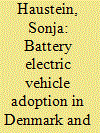

|
|
|
|
|
| Summary/Abstract |
Countries worldwide are trying to increase the share of battery electric vehicles (BEVs) to reach environmental goals. As part of these efforts, the EU project GREAT installed new fast chargers in Denmark and Sweden and provided possibilities to test BEVs and inform about them. To monitor changes in attitudes and behaviours and to estimate the impact of project activities, surveys with BEV and conventional car users were conducted in 2017, 2018, and 2019. We found that attitudes and driving behaviour of BEV users and non-users remained quite stable. While car users in Denmark and Sweden showed similar profiles, one exception was a more negative evaluation of and higher uncertainty about political support for BEVs by Danes. Modelling purchase intention, we found a significant effect of the new fast chargers in Denmark but not in Sweden, while the opposite was the case for information campaigns. Lifestyle compatibility and symbolic-affective attitudes were relevant for BEV adoption in both countries. For cross-border trips, the most relevant factor was whether people had a Tesla or not, reflecting the better driving range and fast charging infrastructure. An increase of charging infrastructure, clearer policy signals and symbolic-affective marketing are discussed as ways to increase BEV adoption.
|
|
|
|
|
|
|
|
|
|
|
|
|
|
|
|
| 6 |
ID:
171510


|
|
|
|
|
| Summary/Abstract |
Individuals' use of smart energy technology – i.e., technology that increases energy efficiency or increases the integration of renewable energy sources – holds great potential to solve the energy-related climate problem. However, individuals' current uptake of smart energy technology is low. If policymakers are to successfully address this issue, it is vital that they understand the determinants of individuals' smart energy technology adoption. Hence, this paper provides a comprehensive adoption model for smart energy technology, including data from over 4k individuals in Europe, Asia, and North America involved in various technological contexts and phases of diffusion. A meta-analysis identifies Attitude and Performance Expectancy as the primary determinants of individuals’ smart energy technology adoption. Further, results show that Environmental Concern influences all other determinants. Implications for research and policymakers are discussed.
|
|
|
|
|
|
|
|
|
|
|
|
|
|
|
|
| 7 |
ID:
132646


|
|
|
|
|
| Publication |
2014.
|
| Summary/Abstract |
This article offers the first national examination of the determinants of adoption of wind and solar energy generation on U.S. farming operations. The inclusion of state policies and characteristics in a multilevel modeling approach distinguishes this study from past research utilizing logit models of technology adoption which focus only on the characteristics of the farm operation. Results suggest the propensity to adopt is higher for livestock operations, larger farms, operators with internet access, organic operations, and newer farmers. The results find state characteristics such as solar resources, per capita income levels, and predominantly democratic voting increasing the odds of farm adoption. This research suggests the relevance of state policy variables in explaining farm level outcomes is limited, although in combination best practice net metering and interconnection policies-policies designed to encourage the development of small scale distributed applications-are shown to increase the likelihood of farm solar and wind adoption. The prevalence of electric cooperatives-which are often not subject to state renewable energy policies and often service farms-is negatively related with the propensity to adopt and suggests that policy design may be a factor
|
|
|
|
|
|
|
|
|
|
|
|
|
|
|
|
| 8 |
ID:
078235


|
|
|
|
|
| Publication |
2007.
|
| Summary/Abstract |
This paper explores whether defense contractors' manufacturing technology advantages over purely commercial firms might be associated with differences in their workforce and organizational practices. It uses unique original data collected specifically to test workforce and organizational complementarities in implementation of advanced manufacturing technology in small manufacturers. Findings are that defense contractors: (1) have higher and deeper rates of advanced manufacturing technology use; (2) have greater perceived success in achieving manufacturing goals; (3) are more likely practitioners across a diverse spectrum of advanced workforce and organizational practices. Then, (4) econometrically, the defense contractors' higher reported levels of achievement in implementing advanced manufacturing technologies are positively associated with those organizational and workforce practice differences
|
|
|
|
|
|
|
|
|
|
|
|
|
|
|
|
| 9 |
ID:
175248


|
|
|
|
|
| Summary/Abstract |
Large organizations wield considerable market power, their procurement activities can be leveraged to achieve social, economic and environmental goals by ‘pulling’ more desirable products into the market. However, while there is substantial research in individual consumer buying behavior and market barriers to sustainable technology adoption, less is known about large organizational buying behavior and the impact of institutional barriers in this area. To address these research gaps, we conducted an exploratory study aimed at better understanding the process through which large organizations purchase sustainable energy technologies and what internal barriers they experience during that process. We surveyed and interviewed 120 individuals involved in procurement from Californian organizations representing both public and private sectors. Survey results indicate the need to resolve the conflict between prioritizing lowest first cost and lowest life cycle cost, better engage multiple stakeholders involved in internal decision-making around purchasing, and improve existing procurement tools or offer new ones. We provide recommendations for how policymakers can apply our findings to increase the adoption of sustainable energy technologies in their own organizations and communities.
|
|
|
|
|
|
|
|
|
|
|
|
|
|
|
|
| 10 |
ID:
125759


|
|
|
|
|
| Publication |
2013.
|
| Summary/Abstract |
Until now, the success of improved cook stoves (ICS) implementation programs has usually been measured by the number of ICS distributed. Some important research has been conducted to try to determine the effects of the use of an ICS in the user's health, but these studies are expensive and time consuming. Moreover, no evaluations show the impact of the technology in the user's lives. This study seeks to contribute to fill this gap.
|
|
|
|
|
|
|
|
|
|
|
|
|
|
|
|
| 11 |
ID:
133088


|
|
|
|
|
| Publication |
2014.
|
| Summary/Abstract |
Electric vehicles represent an innovation with the potential to lower greenhouse gas emissions and help mitigate the causes of climate change. However, externalities including the appropriability of knowledge and pollution abatement result in societal/economic benefits that are not incorporated in electric vehicle prices. In order to address resulting market failures, governments have employed a number of policies. We seek to determine the relationship of one such policy instrument (consumer financial incentives) to electric vehicle adoption. Based on existing literature, we identified several additional socio-economic factors that are expected to be influential in determining electric vehicle adoption rates. Using multiple linear regression analysis, we examined the relationship between those variables and 30 national electric vehicle market shares for the year 2012. The model found financial incentives, charging infrastructure, and local presence of production facilities to be significant and positively correlated to a country×s electric vehicle market share. Results suggest that of those factors, charging infrastructure was most strongly related to electric vehicle adoption. However, descriptive analysis suggests that neither financial incentives nor charging infrastructure ensure high electric vehicle adoption rates.
|
|
|
|
|
|
|
|
|
|
|
|
|
|
|
|
| 12 |
ID:
176651


|
|
|
|
|
| Summary/Abstract |
Trucks in North America account for more than 23% of the transportation sector's greenhouse gas emissions. Truck platooning and truck electrification are potential technologies for reducing emissions and operating cost. However, adoption uncertainties result in speculations about their potential impact. Traditional modeling techniques to inform policymaking use large datasets, trained professionals to calibrate complex software, and take hours to run a single scenario. This paper provides a closed-form model that rapidly calculates trends of the potential national petroleum consumption reduction for a range of technology adoption scenarios. The primary finding is that truck electrification would have a substantially larger impact on fuel consumption reduction than platooning. The limitations of platoonable miles create an upper bound in benefits. When calibrated for the base year fuel-efficiency, the model shows that petroleum consumption reduction would be less than 4% at full adoption of platooning. The electrification of single unit trucks results in more than a 13-fold reduction of national petroleum consumption relative to platooning. However, without the electrification of combination unit trucks, petroleum consumption will eventually begin to increase again. Therefore, policies to encourage the reduction of greenhouse gas emissions should not overlook incentives to electrify combination unit trucks.
|
|
|
|
|
|
|
|
|
|
|
|
|
|
|
|
| 13 |
ID:
115690


|
|
|
|
|
| Publication |
2012.
|
| Summary/Abstract |
Relationships between measures of household energy use behavior and household characteristics are estimated using a unique dataset of approximately 5000 households in 10 EU countries and Norway. Family age-composition patterns are found to have a distinct impact on household energy use behavior. Households with young children are more likely to adopt energy-efficient technologies and energy conservation practices and place primary importance on energy savings for environmental reasons. By contrast, households with a high share of elderly members place more importance on financial savings, and have lower levels of technology adoption, energy conservation practice use, and knowledge about household energy use. Education levels also matter, with higher levels associated with energy-efficient technology adoption and energy conservation practice use. Similarly, university education increases the stated importance of energy savings for greenhouse gas reductions and decreases the stated importance for financial reasons. Education impacts also vary greatly across survey countries and there is some evidence of an Eastern-Western European divide with respect to attitudes towards energy savings. These cross-country differences highlight the need to balance a common EU energy-efficiency policy framework with flexibility for country specific policies to address unique constraints to energy-efficient technology and conservation practice adoption.
|
|
|
|
|
|
|
|
|
|
|
|
|
|
|
|
| 14 |
ID:
170092


|
|
|
|
|
| Summary/Abstract |
This study expands on existing research on farmers' risk preferences and technology adoption, with novel analysis of the relationship between risk preferences, production contract participation, and technology investment levels and adoption time. Our analysis uses farm-level data from 345 Chinese broiler growers, and used an instrumental variables strategy and endogenous switching models to address the potential endogeneity of the contracting decision. Both the distance of the farm to the nearest broiler business and the distance of the farm to the nearest market for broiler sale are used as instrumental variables for the contracting decision. Results indicate that farmers with higher risk aversion are more likely to participate in production contracts, less likely to adopt new technology, adopt technology later, and invest less in technology. In the subsample of contract farmers, production contracts with longer terms, lower upfront deposit requirements and higher cost sharing with enterprises for technology adoption may make farmers more likely to adopt technology, to adopt technology early and to invest more. These findings jointly suggest that contract terms that help alleviate credit constraints may be more effective at promoting technology adoption in developing countries.
|
|
|
|
|
|
|
|
|
|
|
|
|
|
|
|
| 15 |
ID:
171433
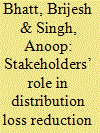

|
|
|
|
|
| Summary/Abstract |
Reduction of distribution losses is the key to sustainability of entire Indian power sector. Although sufficient emphasis has been placed on adoption of distribution loss reduction technologies (LRT) such as high voltage distribution system, it has not made significant inroads. Building on new institutional economics and sociological approaches, we propose actor analysis as a prerequisite for understanding barriers to technology adoption. The approach emphasizes understanding of action situations and power, interests and interdependencies of involved actors for LRT adoption. Using the method of stakeholder analysis, the study identifies key actors and their interdependencies in LRT adoption processes. The paper concludes that loss reduction and LRT adoption policies can be effectively implemented by engaging consumers through information sharing and, by showcasing advantages of LRT projects especially those leading to improvement in quality of electricity supply.
|
|
|
|
|
|
|
|
|
|
|
|
|
|
|
|
| 16 |
ID:
126623


|
|
|
|
|
| Publication |
2013.
|
| Summary/Abstract |
The variation in the adoption of a technology as a major source of competitive advantage has been attributed to the wide-ranging strategic foresight and the integrative capability of a firm. These possible areas of competitive advantage can exist in the periphery of the firm's strategic vision and can get easily blurred as a result of rigidness and can permeate in the decision-making process of the firm. This article explores how electric utility firms with a renewable energy portfolio can become strategically rigid in terms of adoption of newer technologies. The reluctance or delay in the adoption of new technology can be characterized as strategic rigidness, brought upon as a result of a firm's core competence or core capability in the other, more conventional technology arrangement. This paper explores the implications of such rigidness on the performance of a firm and consequently on the energy eco-system. The paper substantiates the results by emphasizing the case of Iberdrola S.A., an incumbent firm as a wind energy developer and its adoption decision behavior. We illustrate that the very routines that create competitive advantage for firms in the electric utility industry are vulnerable as they might also develop as sources of competitive disadvantage, when firms confront environmental change and uncertainty.
|
|
|
|
|
|
|
|
|
|
|
|
|
|
|
|
| 17 |
ID:
186499
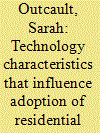

|
|
|
|
|
| Summary/Abstract |
Distributed energy resources (DERs) present an important opportunity to lower the carbon intensity of residential buildings but face numerous barriers to adoption. This paper extends and adapts Rogers' theory of the role of technology characteristics in the diffusion of innovation (Rogers, 1962) to address the unique features of residential DERs. A structured review of the academic and industry literature was conducted to gather data on the technology characteristics that influence residential DER adoption. Careful coding, analysis, and operationalization of the technology characteristics yielded 14 that are relevant, applicable, specific, independent, and distinct from each other. The 14 technology characteristics and logic behind their identification comprise a classification scheme to guide the exploration of how the technology characteristics of residential DERs influence their adoption. Building on that framework, an assessment tool was developed to evaluate technology adoptability, facilitate comparisons across technologies, and identify the specific technology characteristics that pose a challenge for each DER. The framework and the assessment tool can be used by researchers, practitioners, and policymakers to better understand and address the technology characteristics that hinder adoption of residential DERs.
|
|
|
|
|
|
|
|
|
|
|
|
|
|
|
|
| 18 |
ID:
176682
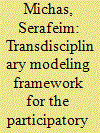

|
|
|
|
|
| Summary/Abstract |
Efficient policymaking is crucial towards climate change mitigation. However, policies’ successful implementation depends largely on the context where they are applied. Classic decision-making used to be based on a static plan that was considered optimal for the “most likely” future contextual outcome. However, predicting the most probable evolution of this context has been proved unsuccessful, since it is vulnerable to unanticipated parameter change. Dynamic Adaptive Policy Pathways can address this problem focusing on the design of short-term policies, with simultaneous definition of adaptive interventions to be chosen on the long-term. This article presents a transdisciplinary modeling framework, which builds on the original Dynamic Adaptive Policy Pathways methodology. To demonstrate the applicability of this framework the authors used it to explore the evolution of the small-scale solar photovoltaics share in Greece, towards the achievement of the national capacity targets of 2025 and 2030. Model outcomes facilitated the identification of several pathways achieving the capacity targets, while reducing the risk for retroactive policy changes. Overall, the presented study demonstrates potential to support the design of adaptive policies over contextual evolutions so that social, economic and technological aspects of integrative planning are balanced towards the achievement of climate targets.
|
|
|
|
|
|
|
|
|
|
|
|
|
|
|
|
|
|
|
|
|